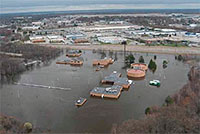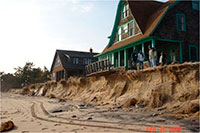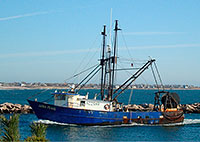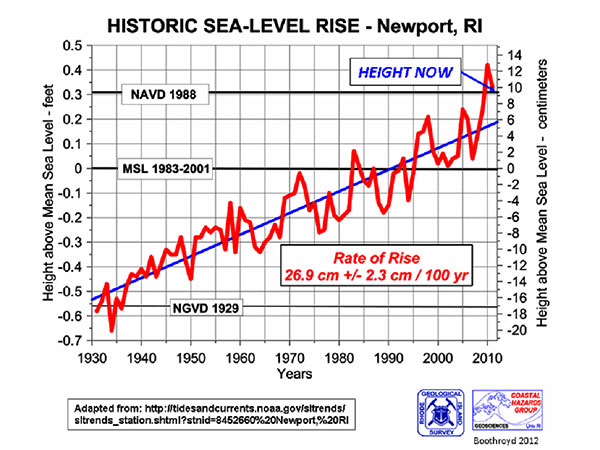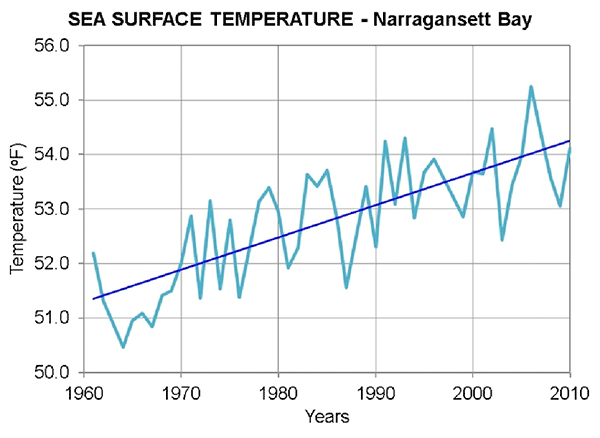Website content other than annual reports last updated May 31, 2013.
Learn More!
- Rhode Island Coastal Resources Management Council: Climate Change and Sea Level Rise
- Sea Level Rise Mapping & Data Tools. RI Sea Grant
- Adapting to Climate Change in the Ocean State: A Starting Point. Rhode Island Climate Change Commission 2012 Progress Report (pdf)
- Exploring Climate Change Resilience Strategies in Rhode Island Urban Under-served Communities. Environment Council of Rhode Island, May 2012 (pdf)
- SafeWater RI. Ensuring Safe Water for RI’s Future. Prepared for the RI Department of Health Office of Drinking Water Quality by Tetra Tech, Inc. May 2012 (pdf)
- Physical, chemical and biological data for Narragansett Bay can be found at narrbay.org
- RI 2010 Climate Risk Reduction Act
- RI Simulated Inundation Surfaces (expected coastal inundation due to sea level rise)
Posters:
- 2013 Assessment Poster (pdf)
- 2011 Assessment Poster (pdf)

Climate Change
Climate change is already happening in the Narragansett Bay region and will intensify in the years to come. Some current observed impacts include increases in air and water temperatures, rising sea level, and increasing rainfall and storm intensity, resulting in more inland flooding and coastal erosion. Based on information from buoys and other monitoring sites throughout the Bay, significant increases in Bay water temperature have been observed over the past decades, with a change in the annual Bay surface temperature of almost 3°F since 1960. Winter bay temperatures have increased by about 4°F, which is causing major ecosystem shifts, affecting the Bay’s fish populations. Sea level has risen nearly 10 inches at the Newport tide gauge since 1930, and is projected to be over three feet by 2100. Coastal storms and their storm surges are now impacting more properties because rising sea levels allow flooding to reach farther inland. The terms shoreline erosion, sea level rise and coastal flooding are on the minds of citizens and decision makers, especially following the devastating impacts of Super Storm Sandy in October 2012.
Recent Papers
Several recent papers describe sea-level rise and anticipated impacts in the Northeast:
- Hotspot of accelerated sea-level rise on the Atlantic coast of North America (published June 24, 2012) by Asbury H. Sallenger Jr, Kara S. Doran & Peter A. Howd
- Modelling sea level rise impacts on storm surges along US coasts (published March 14, 2012) by Claudia Tebaldi, Benjamin H Strauss, and Chris E Zervas
- Tidally adjusted estimates of topographic vulnerability to sea level rise and flooding for the contiguous United States (published March 14, 2012) by Benjamin H Strauss, Remik Ziemlinski, Jeremy L Weiss, and Jonathan T Overpeck
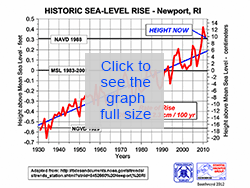
Sea level has risen nearly 10 inches at the Newport tide gage. Rising sea levels increase the risk of coastal flooding. And more storms increases the risk of coastal erosion.
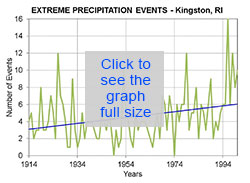
The number of extreme precipitation events (> 2 inches of rain in less than 48 hours) occurring annually has doubled since 1914. These storms increase the risk of inland flooding.
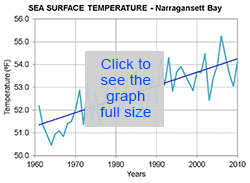
Narragansett Bay’s average annual surface temperature has increased by almost 3°F over the past 50 years. Warmer temperatures change the marine ecosystem and will affect valuable fisheries.
Climate Change: 2013 Assessment
Status and Trends: Climate Change is here. Rhode Islanders and people everywhere are dealing with the impacts and will continue to face increased temperatures, storminess, and sea level rise in the years to come.
Management: Rhode Island is taking actions to adapt and respond to Climate Change. Increased monitoring and continued coordination along with public dialog is needed.
Climate Change: 2012 Assessment
Status and Trends: Climate Change is here. We are dealing with the impacts and will continue to face increased temperatures, storminess, and sea level rise in the years to come.
Management: RI is taking action to adapt and respond to Climate Change. The State Climate Change commission has convened and subcommittees are at work.
Climate Change: 2011 Assessment
Status and Trends: Climate Change is here. We are dealing with the impacts and will continue to face increased temperatures, storminess, and sea level rise in the years to come.
Management: RI is taking action to adapt and respond to Climate Change.
Workshop Documents (in Adobe Acrobat format)
Presentations
- Climate change impacts in RI: What are the data telling us? by Jim Boyd (CRMC)
- Sea Surface Temperature Data Overview by Q Kellogg(URI CI)
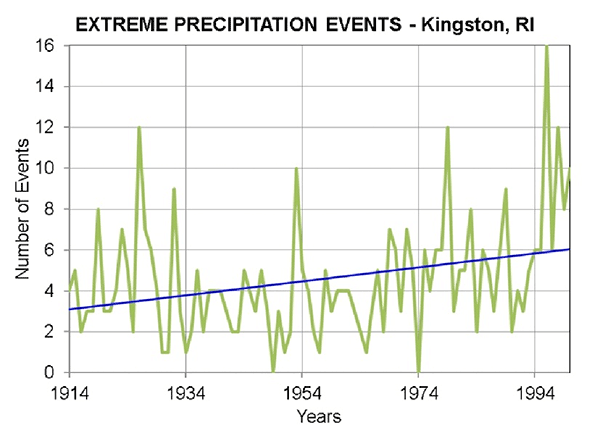
Data: New England Integrated Science and Assessment
